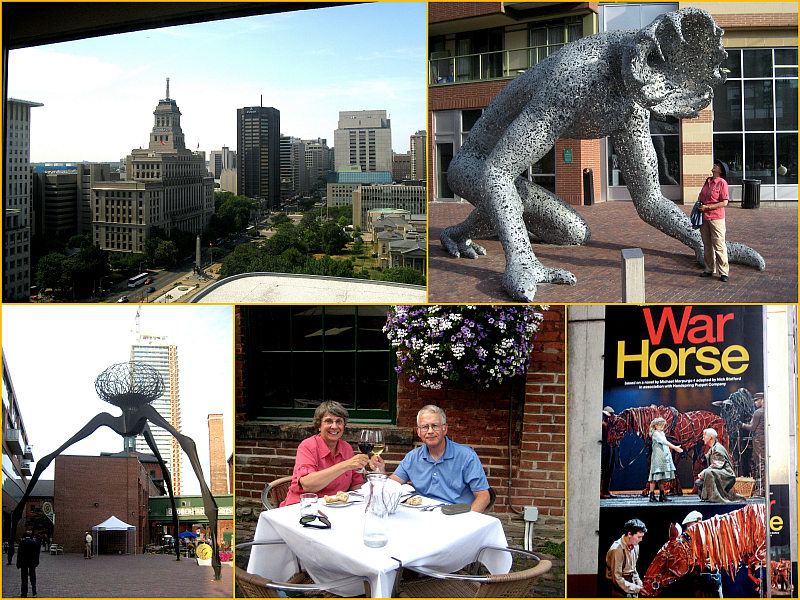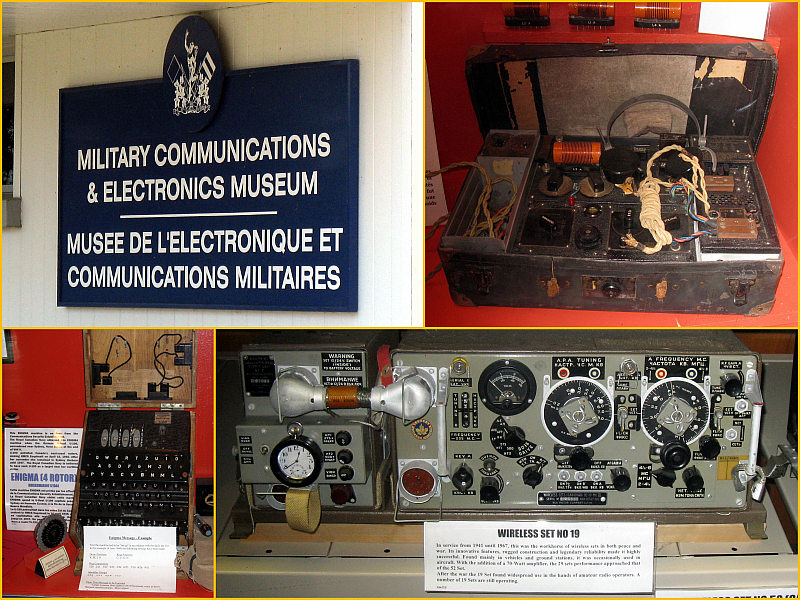Toronto, Canada

| Canadian Vacation - Cruising the St. Lawrence - July 2012 |
|---|
| | | Return to Home Page | | |
|---|
Introduction
We'd been considering a river barge trip in Europe, but, with no cruising experience, decided to start small with one on the St. Lawrence River. I'd read the stage play Warhorse was running in Toronto. Horses again, had to see it. Next stop, Kingston, Ontario, to visit local sites before boarding our ship. Leaving the ship In Ottawa we spent several more days in the capital on our own.
In the photo above upper left, a view of downtown Toronto from our hotel room on the 17th floor. Upper right, Joyce and friend, Michael Christian's recently removed sculpture - Koilos , on a pedestrian walkway in the Distillery District. Lower left, Another Michael Christian creation, I.T. originally shown at the Burning Man gathering. Lower center, Joyce and moi at dinner in the district. Lower right, We attended the Canadian Company production of Warhorse at the Princess of Wales Theatre. While the stage production can't match the physical scope of the film the emotions triggered by the intimacy of the theater was overwhelming.
| | | Return to Home Page | | |
|---|
Above upper right, is a photo of the National Gallery of Canada. Lower right, the Notre Dame Roman Catholic Basilica National Historic Site of Canada. is located on the edge of the Byward Market. Lower left, Though Canadian participation in U.N. peacekeeping missions has declined the Canadian Forces has a long history of participation. The Reconciliation peacekeeping monument fronts the Art Gallery. Upper left, a herd of prairie horses sculpted by Joe Farad gallops in the National Gallery of Art Sculpture Garden.
| | | Return to Home Page | | |
|---|
Military Communication and Electronics Museum, Kingston, Canada

Military Communication and Electronics Museum, Kingston, Canada
Our host at the The Tymparon Inn (sadly now closed) Kingston Bed & Breakfast shared the hobby of ham radio together. He suggested I tour the Military Communication and Electronics Museum, Kingston, Canada. Electrical engineer / Ham radio operator heaven on earth! The museum presents the history of the troops, times and technology of the Canadian forces. In the photo above, upper left the entrance to the museum in both English and French. This is bilingual Canada after all. Upper right, A WWII radio designed for use by resistance forces behind enemy lines. Lower left, one of many versions of the German Enigma machine used in WWII. The Germans were so confident that the code could not be cracked they continued using it to the end of the war. In the meantime every message sent was intercepted and decoded in England and the U.S. Lower right, Wireless Set No. 19, designed in England and refined in Canada the 19 was the communication workhorse of Canadian forces in WWII. Note the Russian control labels. The set was provided to Soviet forces during the war.
| | | Return to Home Page | | |
|---|
We boarded ship, our home for the next 5 nights & 6 days, at Kingston, Ontario. In the photo above, upper left, shipboard romances, an intoxicating rush with someone new striking without warning. For Joyce it was the ship bartender. He personally selected and served lunch and dinner wines for her enjoyment. Top center, I enjoyed sitting in a chair watching the water, fine homes on the shore and small boats on the river, was very relaxing. When interest waned here was a great place to read a trashy novel. Upper right, The M/V Canadian Empress docked at Coteau Landing. Lower right, The Chief Engineer provided a personal tour of the engine room. A combination of low ceilings and four diesel engines made for cramped and noisy quarters. Lower left, the wheelhouse.
| | | Return to Home Page | | |
|---|
In the photo above, lower left, the Canadian Parliament building sits on Parliament Hill. Lower center, the entrance to the rotunda. Upper left, Changing of the Guard on the great lawn before the Parliament building. Situated on Parliament Hill The troop marches from their quarters through city streets while onlookers can traipse along behind. Upper right, The Senate chamber of the Canadian Parliament. Lower right, one of many beautiful stained glass windows in the Parliament building.
| | | Return to Home Page | | |
|---|
The Canadian perspective of the war is rarely considered in the United States. Fort Henry is located adjacent to the Royal Military College of Canada in Kingston, Ontario. The first Fort Henry was built during the War of 1812 to deter an American invasion of Lower Canada. It served its' purpose. U.S. forces never attacked it. The fort was abandoned after the war then rebuild 1832 to 1837. That fort is what we see today. A gun crew prepares to fire a cannon on the fort rampart. Center right, the fort mascot, David X, leads off the daily Garrison Parade. Lower right, The garrison performs a bayonet exercise.
Fort Wellington's not so grand nor was it intended to be. It served as a tripwire against the American invasion in the War of 1812. Above, upper right, a historically accurate representation of Fort Wellington. The fort was built of rammed earth reinforced with horizontal frieze, rows of sharpened stakes pointing toward the enemy. As the War of 1812 began both Canadian and American locals adopted a live and let live policy, the peace was maintained. American forces from New York changed the situation and, against orders, attacked the fort. The Americans were soundly defeated, as was a second attack in 1813. Lower left, docents dressed in accurate period reproduction uniforms, provided a thorough tour of the fort. They closed with a demonstration of their Brown Bess muzzle loading muskets, three shots a minute for a trained soldier.
| | | Return to Home Page | | |
|---|
On day 3 of our cruise we visited Upper Canada Village. Dams on the St. Lawrence drowned low-lying towns. Before the waters covered them select buildings were dismantled and stored preserving the history. Upper Canada Village restores the flavor of an 1866 town on the eve of Canadian independence. In the photo above, upper left, horses, horses & horses, I was in heavan. I give in to every temptation to photograph them. This handsome pair pulled our carriage on a "Get The Lay of the Land" drive through the village. Lower right, we rode this miniature train to the village. Bottom center, This gang of piglets enjoyed the run of the village. The village did not always enjoy the piglets. We watched as a farm woman chased several that were rooting her garden. The cheese maker gave us the secret of why American Cheddar Cheese is yellow.
Next stop, Cumberland Village. In the photo upper right, this docent taught us how to make sugared flowers. Bottom left, the resident potter showed us how to make a pot from raw clay to ready for firing. The village features many excellent docents, particularly enjoyable were the brewer and blacksmith.
| | | Return to Home Page | | |
|---|